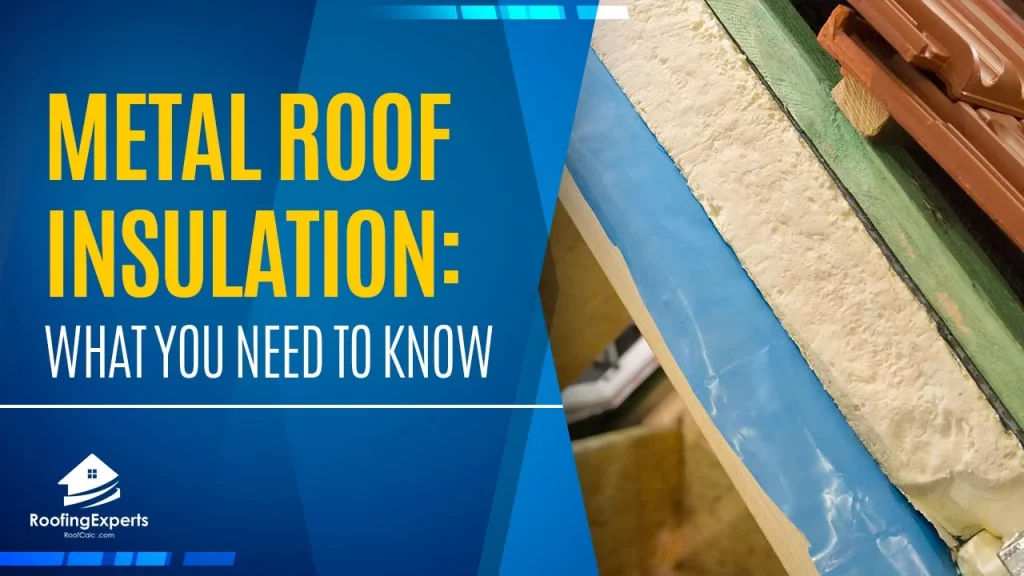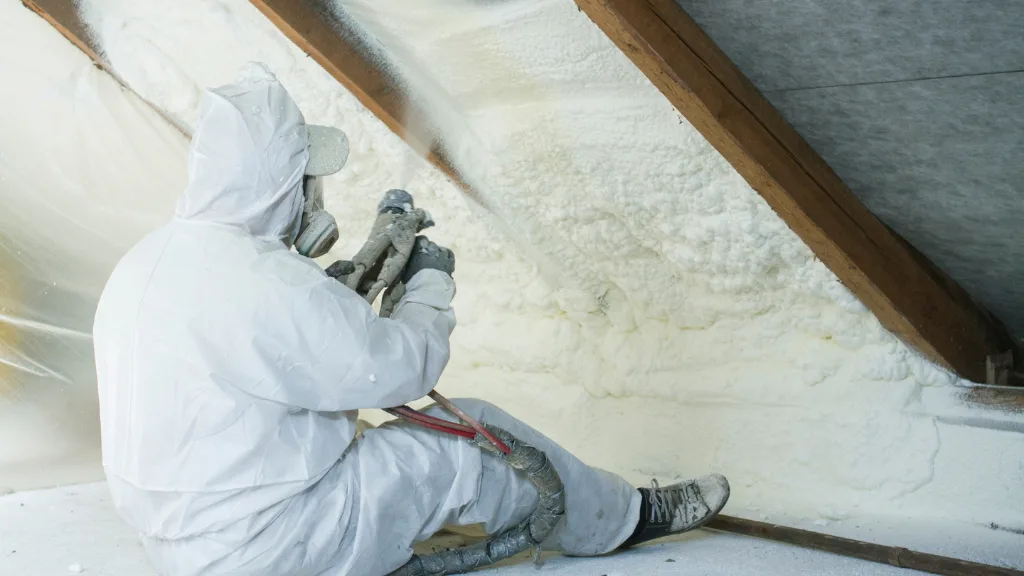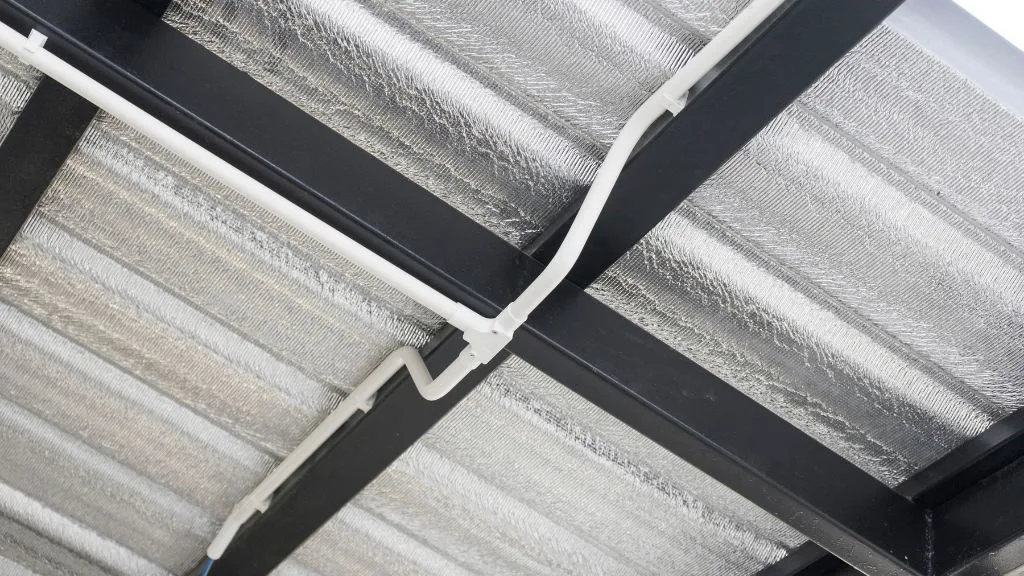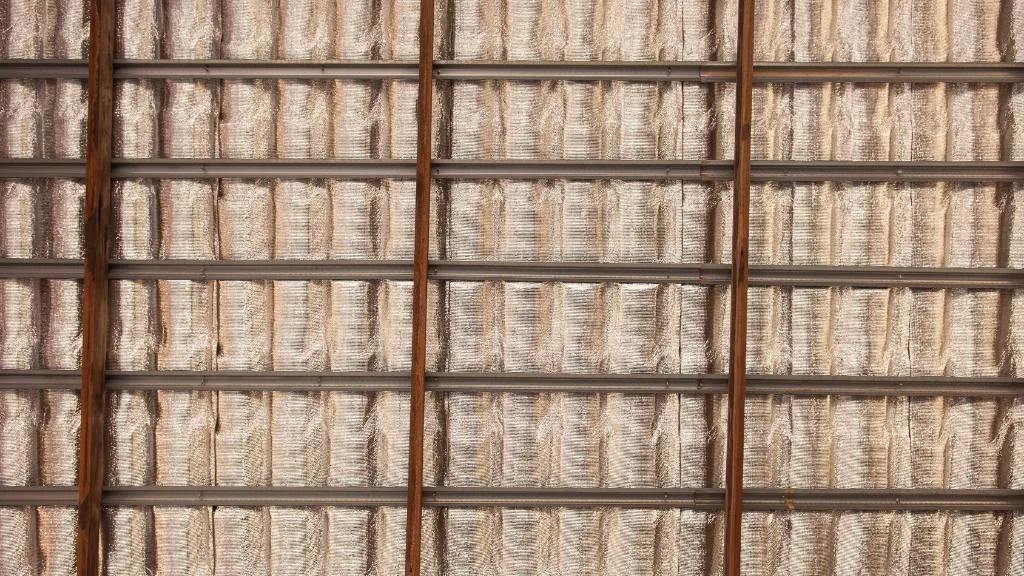
A metal roof is a type of roofing that is made from a thin sheet of steel. If you have a metal roof, it might be time to consider adding insulation in order to keep your home comfortable and energy efficient year-round. In this blog post we go over Metal Roof Insulation and the important factors you need to know!
Foundation, roof, and wall insulation is made of this material. It’s used to provide thermal resistance to foundations, roofs, and walls.
Polystyrene and polyurethane are used to make it. It is available in sheets or panels of various sizes, depending on the manufacturer.
- Rigid foam insulation is a good choice because it provides maximum thermal resistance.
- Rigid Board Insulation is denser and thinner than the other options which helps reduce air leakage.
- Rigid Board insulation can be difficult to install, but is very effective at preventing heat loss.
- Rigid board insulation is tight and must be fitted to prevent air infiltration.
- Rigid Board Insulation doesn’t work well with air flow because the joints have to be taped or sealed.
- Rigid Board Insulation is not as effective in insulating when joints are left open.
- Rigid Board Insulation is a type of insulation that can be damaged by UV rays from sunlight, making installation an important step.
- The cost of rigid board insulation ranges from $3.95 to $7.20 per square foot.
Fiberglass Batts for Insulation
This type of insulation is made from long strands of fiberglass that are tightly bound together.
It can be easily cut to fit around pipes and other obstacles on your roof, which makes it a good choice for DIYers who want the freedom to customize their installation process.
Fiberglass batts come in pre-cut sizes or as large panels. It is important that you measure your roof before purchasing insulation, and then cut the fiberglass to fit.
This insulation material is made of threads that can be woven together and mixed with other materials to form a thick pad. The glass in this material is made of the same substance that glasses are usually made out of.
- Some people choose to use fiberglass batts because they’re one of the cheapest and easiest ways to insulate a metal roof.
- Property owners choose fiberglass batts because they are versatile and can be installed on a metal roof.
- However, fiberglass batts are not safe to use. Fiberglass batts can be harmful to installers. When installing fiberglass batts, it is critical to use protective clothing.
- As for the cost, fiberglass insulation costs are different depending on the R-value.
Spray Foam Insulation
Fiberglass insulation is sprayed onto the outside of a building to insulate it. Polyurethane foam is a type of material that expands and hardens after being exposed to air.
- Spray foam insulation pros include that it is effective for metal roofing and easy to work with.
- Spray foam insulation is a great option for people looking to add insulation without having to reroof.
- Spray foam insulation pros are that it is self-adhering and an excellent option for difficult to insulate areas.
- Spray foam insulation is a reliable choice for insulating homes.
- Spray foam insulation has disadvantages such as the need for professional installation.
- Spray Foam Insulation can be difficult to install with bad results if not done professionally.
- Spray foam insulation is available in two types of open and closed cells. Spray foam insulation is available in two types, which can cost $1.50 per board foot and $0.44-0.65 per board foot

How to Insulate a NEW Metal Roof
Before installing an underlayment or insulation on top of a NEW metal roof, you must first ensure that the surface is clean and smooth. The last thing you want to do is trap anything under your new metal roof that could cause it to fail prematurely.
So, now is the time to wash it and remove all dirt and debris (like sand and gravel) using a pressure washer.
You can also use a broom or blower to make sure there are no pebbles or loose particles remaining on the surface.
Installing the Underlayment
Once you have the metal roof in top condition, it’s time to install your underlayment. The type of material you choose depends on the type of insulation product you plan to use and what your roof covering manufacturer recommends.
While not necessary for most types of insulation, if your manufacturer specifically states that you should install their underlayment before installing your insulation product, then follow their instructions.
If you are not sure what the manufacturer of your metal roof recommends, it’s best to check with them first before proceeding with your project.
How to Add Insulation to an Existing Metal Roof
Adding insulation to an existing metal roof is a relatively easy job. If you have an older home, this can be a cost effective way of saving on energy costs and increasing the comfort level/apparent temperature inside your home.
There are many different types of metal roofs that come in a variety of colors and styles. For example, steel roofs come in blue, silver, and even green.
Copper roofs come in red/pink, brown, and various shades of green. Galvanized steel roofs can be white or cream colored.
It is necessary to remove the existing metal roofing panels to add additional insulation behind them; this will ensure that you get the most out of your project.
You could simply add insulation to the existing metal roof, but you would not be getting as much as you could because there is a chance that some of the cold air will still leak through.
Take your time removing the old panels to make sure everything goes smoothly. Be careful when using sharp tools or anything else that might cause damage to the roof.
If the old panels cannot be removed, try to find out why. You may need a structural engineer or other professional to come and inspect the roof before you continue your project.
Before you buy any materials for this project, such as insulation, make sure you know what type of roofing material is currently on your home so that it will fit properly.
There are several different types of insulation to choose from for your project. So make sure to consult with your roofing contractor beforehand to have a better idea of what you want to do.
Benefits of Metal Roof Insulation
The first benefit of insulation is the fact that it will help keep your home more comfortable and energy efficient.
When you install a metal roof, one thing to consider is how well insulated it should be – after all, there won’t be any air or vapour barrier on top! You need to do some research on your metal roof to make sure you choose the right insulation for it.
Insulating your metal roof will save you money. Energy loss through roofs accounts for up to 25 percent of all energy used in the average home.
Metal roofs are not insulated, making them one of the biggest culprits for losing valuable heated or cooled air. Insulating your metal roof with either spray-in foam insulation or reflective bubble insulation is an easy way to reduce your energy costs.
You can insulate a metal roof yourself or hire a professional, depending on the size of the job and your experience level.
You can do this in one day without spending too much money. High quality insulation will have at least a 10 year warranty for labor and materials, so ensure you are comfortable with the contractor you hire.

Reduce Roof Noise
If you have a metal roof, then you know that it is an excellent noise barrier against rain and hail; however, it can also act as a major sound amplifier.
If your house is located in close proximity to an airport or train tracks, for example, insulation will help reduce the rumbling noise.
Modern metal roofs are less likely to amplify sounds than older styles were, but insulation will still help reduce the sound of rain and other outside noises.
If you live in a very noisy area, such as around an airport or train tracks, check with your local home improvement store for the most sound-resistant insulation available.
Insulate Against Hail Damage
Metal roofs are considered hail resistant, but they are not immune to damage from this wind-borne object. You can reduce the risk of hail damage by adding insulation between your metal roof and underlayment.
The added layer of protection will help prevent dents due to hail stones, which is especially important for those who live in an area where hail is common.
Insulate Against More Heat and Cooling Losses
Metal roofs lose a great deal of heat during the summer and also absorb more cold than most other types of roofs. The color or coating on your metal roof can influence how much heat is absorbed.
Black metal roofs often absorb more heat than lighter-colored ones, and they will naturally push more heat inside the attic and your home in general.
Conversely, white or light-colored roofs stay cooler and reflect most sunlight away from the house and roof surface itself, reducing heating costs and increasing comfort levels when it is hot outside.
However, when it is cold outside, dark metal roofs can help warm your home and reduce heating expenses.
A layer of insulation will help prevent your metal roof from absorbing or losing too much heat, which can translate to lower energy costs and greater comfort levels all year round.
More Information on Metal Roofs and Insulation
Most houses and buildings in the United States and other developed countries are constructed with a roof that is typically made of plywood or OSB (oriented strand board) covered with an asphalt shingle, TPO (thermoplastic polymer) or EPDM (ethylene propylene diene monomer) rubber membrane.
Most homes built since the early 1900s have had the same type of roofing material over the years. However, metal is making a comeback due to its many benefits including durability, low maintenance, energy efficiency and fire resistance.
Metal roofs are also considered by some in the green building industry to be even more sustainable than wood-shake or shingle roofs in that they out-perform these other roof types in terms of energy efficiency and life expectancy.
So, given all the benefits of metal roofs, why aren’t more homes built with them?
The answer is that historically there has been a big drawback to metal roofs: they have not been insulated. And insulation is one way to decrease utility bills and increase comfort of your home.
Insulation, along with proper ventilation and air sealing can make a big difference in the overall energy efficiency of your home or building.
The more energy efficient the building envelope is (air-sealed, well-insulated ceilings, walls and floors), the less heat will escape during colder months and enter the house during the summer.
The typical asphalt shingle roof is not insulated, but the newer TPO and EPDM rubber roofs are designed to be used with insulation between the structural decking of the roof and the membrane itself.
This means that if you plan on putting any type of insulation under your metal roof, it must be installed above your existing roof decking before the new metal roof is installed.
It’s worth noting that some manufacturers of metal roof material will void your warranty if you install insulation under their product, so be sure to check with your vendor to see whether or not this is a possibility on your project.
Final Thoughts
High quality insulation will have a 10 year warranty for labor and materials. If you are getting a new roof, it might be cost effective to get insulation added before the metal shingles go on.
Some of this will depend upon your budget and how much money you have for the project. The best option is usually not having any gaps in coverage where drafts can come through or heat/cool loss occurs.
And make sure to hire the pros to do the job!

